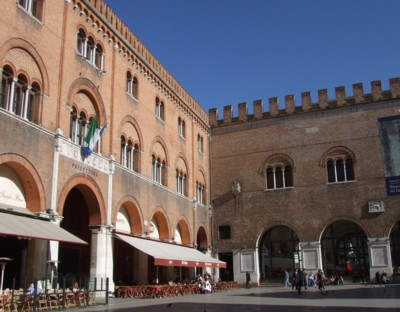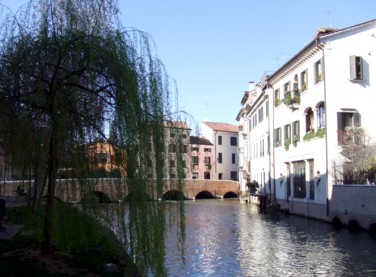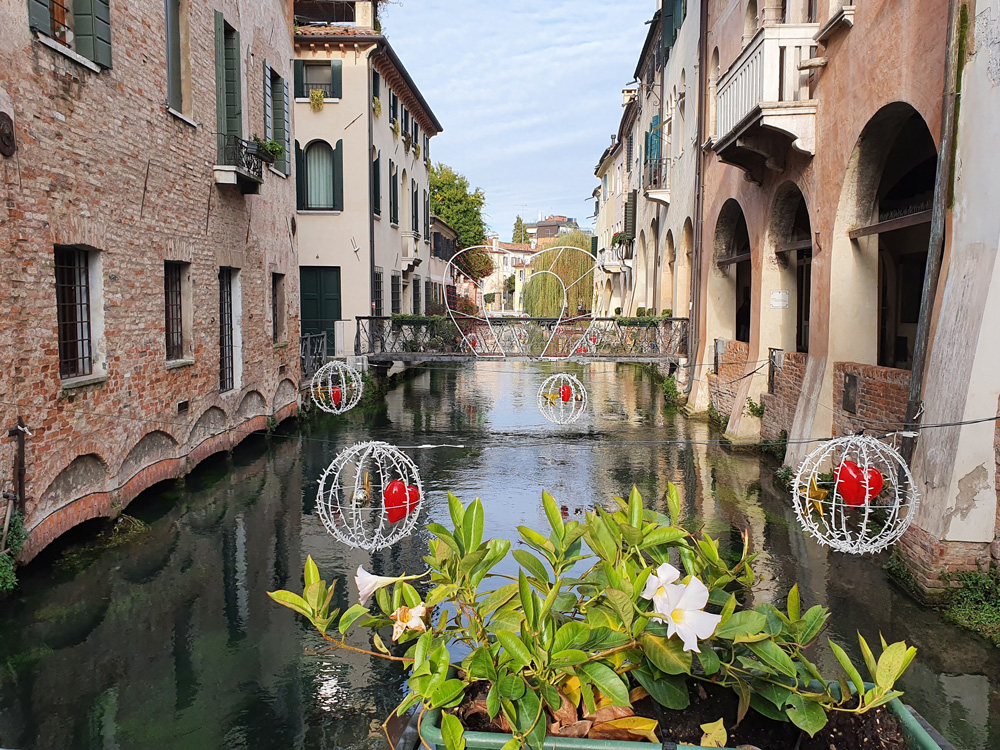About Treviso
Treviso is an attractive town in the Veneto region of north-east Italy, with a population of around 80,000. From a tourist point of view, it suffers from its proximity to glamorous Venice: Treviso’s meandering waterways and tranquil atmosphere just can’t compete with the overwhelming charms of its neighbour. In its own right, though, Treviso is a pleasant town with several attractions worthy of a day trip. It also makes a good base for exploring the area (including Venice), or for enjoying a quiet Italian break.
Rebuilt and restored after Second World War bombing, the town centre is a rambling maze of streets lined with arcaded walkways. Looking up, you’ll see fragments of the painted frescoes which once decorated Treviso’s houses. The town is circled by a town wall and by waterways. Treviso markets itself as a città d’acque and although it can hardly compare with its lagoon neighbour, water is an important feature of the townscape. The river Sile runs to the south of the centre, and canals carry water around the town, lined with houses or grassy banks, weeping willows, waterwheels and little parks. The town’s defensive walls, moat and imposing gateways are still impressive sights.

One of Treviso’s other notable features is its comfortable air of prosperity. The town is home to the clothing empire Benetton, which has a large store behind the Palazzo dei Trecento in the town centre. Unlike Venice, this town doesn’t depend on tourism – you won’t find tacky tourist shops, silly hats or bullying tour guides, just a well-off Italian town going about its daily business.
Find and book hotels. With location maps and guest reviews.
Visiting Treviso
The centre of Treviso is only 5-10 minutes on foot from the railway station. Leaving the station, follow the signs to the centro – there’s a convenient underpass – and walk along Via Roma, which crosses the River Sile and becomes Corso del Popolo. When this street forks, take Via XX Settembre veering to the left. This brings you to the town’s civic heart, Piazza dei Signori, a pleasant square with a street running along one side and cafés with outdoor tables along the other. The dominant building here is the historic town hall, the Palazzo dei Trecento.

Treviso’s tourist information office is in the little Piazza Monte di Pietà, just behind Piazza dei Signori. The office stocks a small selection of information leaflets about the province, town maps and a leaflet of walks around Treviso’s waterways. We’d recommend picking up one or two of these; the maps are useful and the itineraries explore interesting sights like the fishmarket on a little island and some of the town’s working waterwheels.
Treviso’s smartest shopping street, Via Calmaggiore, stretches from Piazza dei Signori towards the Duomo, between the lengthy rows of arches which characterise Treviso’s arcaded streets. Piazza del Duomo is a slight disappointment; the square is used as a car park, with a domineering neo-classical portico masking the historic cathedral. A series of grand make-overs has had the effect of concealing most of the evidence of the building’s earlier history. Some of the layout and the domes which can be seen from outside still record the building’s Romanesque incarnation, an era which is better preserved in the baptistry alongside. The most interesting part of the Duomo is the crypt, which contains extensive fragments of coloured medieval frescoes. Visitors will need some small change (currently 30 cents in 10 and 20 cent pieces) to illuminate the crypt and the same for the fine Titian altarpiece, an Annunciation, which is the Duomo’s prize possession.
The main Treviso museum is the Museo di Santa Caterina, a former church and convent which has recently been restructured to house the Civic Museum, the town’s art gallery and archaeological collection. Cloisters inside the entrance lead through to the church, decorated with lovely patches of fresco which have been restored to vivid colour. Tomaso da Modena’s renowned St. Ursula frescoes are displayed in the centre of the church. You’ll become familiar with the name of Tomaso da Modena as you tour Treviso. The fourteenth-century artist’s charming frescoes pepper the city’s churches and rank among the best art you’ll see here. Back in the main part of the museum, there is an extensive archaeological section, only labelled in Italian but still worth a visit. The museum incorporates a ‘modern’ gallery of nineteenth and twentieth-century paintings. Upstairs is the historic collection, where exhibits include Lorenzo Lotto’s Portrait of a Dominican and works by Francesco Guardi, Rosalba Carriera, Sebastiano Ricci, Francesco Hayez and an unexpected English touch: a portrait of Canova by Thomas Lawrence. The museum is in Piazzetta Botter. It’s open from Tuesday to Sunday 9am-12:30 and 2:30-6pm.
Treviso has other churches which are actually more appealing than its Duomo. The Chiesa di San Francesco is a cool high brick structure with a massive ship’s keel roof. The decorative highlights are some faded medieval frescoes. In a chapel off the transept to the left of the main altar is a fresco by Tomaso da Modena of an enthroned Madonna with attendant saints – some of the colour has been lost but his faces retain their sweetness. The work is echoed less convincingly by another artist in the end chapel.
In the opposite corner of town lies the strikingly-elongated Chiesa di San Nicolò, a fine example of Italian Gothic architecture which looks as though it has been stretched upwards to the heavens. Tomaso da Modena left his mark here too, contributing a San Gerolamo to the prettily-decorated columns inside the church. Next door to the church (separate seminary entrance; to the left as you leave the church), and off a cloister, you’ll find more Tomaso da Modena highlights. In the chapterhouse (Sala del Capitolo) of the monastery, he painted a frieze of portraits of clerics. It’s a lovely series: monks illuminating manuscripts, studying, or looking suspiciously bored. The portraits include what is said to be the earliest portrayal of a person wearing spectacles. The Sala del Capitolo is free to visit (with a box for donations). Ask permission at the entrance to the seminary, and follow signs around the cloister.
Treviso is a pleasant place to wander, and it’s well-provided with enticing bars, cafés and restaurants for sampling the local cuisine and sparkling Prosecco. If you want a quiet getaway for a romantic weekend, Treviso is a practical destination (thanks to Ryanair) with the added possibility of a day trip to Venice.
Practical tips
As normal in Italy, the tourist office and churches are usually closed at lunchtime. The tourist office reopens at 2pm, the churches at around 3.30pm. For a cheap self-service lunch, I recommend the branch of Brek on Corso del Popolo. These cheap restaurants, spread through northern Italy, offer good cheap food, with choices of pasta, salads and ‘main’ meat dishes and wine on tap. The Treviso Brek has a large and airy upstairs seating area which is pleasantly decorated with books and prints. For luxury chocolate ice-creams, visit Venchi on Via Calmaggiore, which has a rich and mouthwatering selection. If you then need to walk off the calories, or are looking for a picnic spot, there is a pleasant stroll along part of the city ramparts, dotted with benches. This is a good walk to do with children – the gravel walkway is shady and looks down over a canal-moat where there are ducks to spot and even some chickens and a goat housed on a grassy bank.
Treviso transport
Treviso has a small international airport, which is served by Ryanair with budget flights from the UK. Ryanair label the airport ‘Venice (Treviso)’ and the majority of travellers hop straight on the bus to Venice, ignoring the hopeful Treviso publicity posters around the airport. A bus run by local firm MOM (number 6) stops on Via Noalese outside the airport and runs to Treviso railway station. Tickets can be bought either in the airport or on the bus.
> Treviso Airport
Treviso has frequent rail and coach connections from Venice. The train is faster, taking half an hour from Venice’s Santa Lucia station, and it’s cheap too. Bus services between Venice and Treviso are run by ACTV, and can take around an hour (depending on traffic); this is a slightly more expensive option than the train.
Things to do around Treviso
Treviso is in easy reach of Venice for day trips. Vicenza and Padua (Padova) can be reached in around an hour by train, and Verona is two hours’ train journey away. The Veneto’s Palladian villas are also great destinations for those with an interest in architecture. If wine or rural landscapes are more to your taste, you could tour the Prosecco-producing area of the Veneto – at the tourist information office you can pick up a leaflet detailing ‘L’Anello del Prosecco’ (the Prosecco ring), a 10km footpath connecting villages and vineyards. See the Valdobbiadene link on the right.
On this site
Veneto art & architecture itinerary
Useful external links
A day in Treviso: travel blog & video
Valdobbiadene Anello del Prosecco
Veneto destinations
- Veneto region
- Abano Terme
- Asolo
- Bassano del Grappa
- Brenta Canal
- Caorle
- Castelfranco Veneto
- Chioggia
- Cittadella
- Concordia Sagittaria
- Conegliano
- Cortina d’Ampezzo
- Lido di Jesolo
- Malcesine
- Marostica
- Monselice
- Montegrotto Terme
- Padua
- Portogruaro
- Rovigo
- Sottomarina
- Treviso
- Venetian Lagoon
- Venice
- Verona
- Vicenza
- Veneto art & architecture itinerary
- Veneto villas – Vicenza: La Rotonda & Villa Valmarana ai Nani
- Veneto villas – Villa Pisani & Villa Foscarini Rossi, Strà
- Venice Airport
- Treviso Airport
